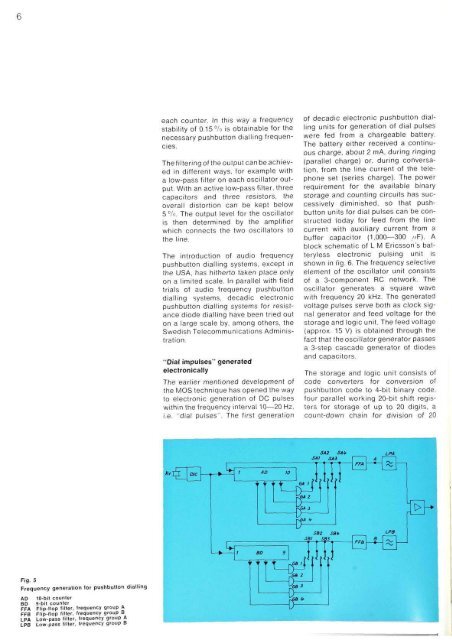electronic telephone sets coaxial cable systems - The history of ...
electronic telephone sets coaxial cable systems - The history of ...
electronic telephone sets coaxial cable systems - The history of ...
You also want an ePaper? Increase the reach of your titles
YUMPU automatically turns print PDFs into web optimized ePapers that Google loves.
6<br />
Fig. 5<br />
Frequency generation for pushbutton dialling<br />
AD 10-bit counter<br />
BD 9-bit counter<br />
FFA Flip-flop filter, frequency group A<br />
FFB Flip-flop filler, frequency group B<br />
LPA Low-pass filter, frequency group A<br />
LPB Low-pass filter, frequency group B<br />
each counter. In this way a frequency<br />
stability <strong>of</strong> 0.15 % is obtainable for the<br />
necessary pushbutton dialling frequencies.<br />
<strong>The</strong> filtering <strong>of</strong> the output can be achieved<br />
in different ways, for example with<br />
a low-pass filter on each oscillator output.<br />
With an active low-pass filter, three<br />
capacitors and three resistors, the<br />
overall distortion can be kept below<br />
5 °/o. <strong>The</strong> output level for the oscillator<br />
is then determined by the amplifier<br />
which connects the two oscillators to<br />
the line.<br />
<strong>The</strong> introduction <strong>of</strong> audio frequency<br />
pushbutton dialling <strong>systems</strong>, except in<br />
the USA, has hitherto taken place only<br />
on a limited scale. In parallel with field<br />
trials <strong>of</strong> audio frequency pushbutton<br />
dialling <strong>systems</strong>, decadic <strong>electronic</strong><br />
pushbutton dialling <strong>systems</strong> for resistance<br />
diode dialling have been tried out<br />
on a large scale by, among others, the<br />
Swedish Telecommunications Administration.<br />
"Dial impulses" generated<br />
<strong>electronic</strong>ally<br />
<strong>The</strong> earlier mentioned development <strong>of</strong><br />
the MOS technique has opened the way<br />
to <strong>electronic</strong> generation <strong>of</strong> DC pulses<br />
within the frequency interval 10—20 Hz,<br />
i.e. "dial pulses". <strong>The</strong> first generation<br />
<strong>of</strong> decadic <strong>electronic</strong> pushbutton dialling<br />
units for generation <strong>of</strong> dial pulses<br />
were fed from a chargeable battery.<br />
<strong>The</strong> battery either received a continuous<br />
charge, about 2 mA, during ringing<br />
(parallel charge) or, during conversation,<br />
from the line current <strong>of</strong> the <strong>telephone</strong><br />
set (series charge). <strong>The</strong> power<br />
requirement for the available binary<br />
storage and counting circuits has successively<br />
diminished, so that pushbutton<br />
units for dial pulses can be constructed<br />
today for feed from the line<br />
current with auxiliary current from a<br />
buffer capacitor (1,000—300 /(F). A<br />
block schematic <strong>of</strong> L M Ericsson's batteryless<br />
<strong>electronic</strong> pulsing unit is<br />
shown in fig. 6. <strong>The</strong> frequency selective<br />
element <strong>of</strong> the oscillator unit consists<br />
<strong>of</strong> a 3-component RC network. <strong>The</strong><br />
oscillator generates a square wave<br />
with frequency 20 kHz. <strong>The</strong> generated<br />
voltage pulses serve both as clock signal<br />
generator and feed voltage for the<br />
storage and logic unit. <strong>The</strong> feed voltage<br />
(approx. 15 V) is obtained through the<br />
fact that theoscillatorgenerator passes<br />
a 3-step cascade generator <strong>of</strong> diodes<br />
and capacitors.<br />
<strong>The</strong> storage and logic unit consists <strong>of</strong><br />
code converters for conversion <strong>of</strong><br />
pushbutton code to 4-bit binary code,<br />
four parallel working 20-bit shift registers<br />
for storage <strong>of</strong> up to 20 digits, a<br />
count-down chain for division <strong>of</strong> 20<br />
FFB
















